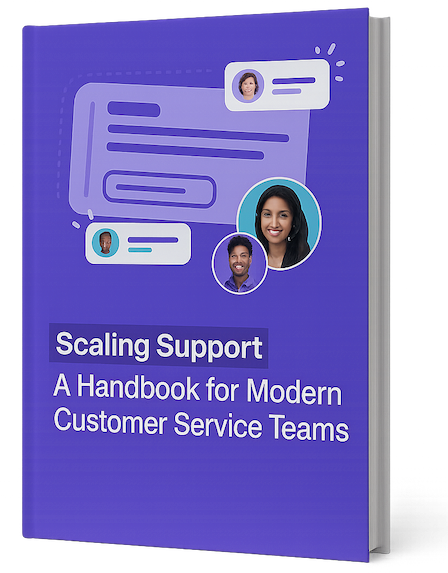Understanding Modern Customer Service Personalization

The landscape of customer service has evolved significantly. Recent studies show that 76% of customers now expect personalized interactions when dealing with businesses. This shift reflects a fundamental change in how people want to be treated – not as ticket numbers, but as individuals with unique needs and preferences. Basic scripts and generic responses no longer meet customer expectations.
The Power of Personalized Interactions
When businesses take time to understand and adapt to individual customer needs, the impact is significant. Imagine calling your bank and having the representative immediately recognize you and reference your recent transactions without asking you to repeat information. Such seamless experiences, combined with relevant product suggestions based on your history, create effortless and meaningful interactions. This approach helps customers feel valued while making service interactions more efficient.
Driving Revenue Through Personalization
The business case for personalized service is compelling. Companies that implement thoughtful personalization strategies see revenue increases of 10-15%, with some achieving gains up to 25%. For example, when online stores recommend complementary items based on what's in your cart, they're not just being helpful – they're creating additional sales opportunities. This approach benefits both parties: customers discover relevant products while businesses increase their sales.
Personalization and the Psychology of Connection
At its core, the desire for personalized service stems from basic human needs. We all want to feel recognized and appreciated. When businesses remember customer preferences and treat people as individuals rather than numbers, they build genuine connections. A company that remembers your past purchases and preferences feels more like a trusted partner than an impersonal corporation. This human element leads naturally to increased loyalty and word-of-mouth recommendations. Simply put, people prefer doing business with companies that make them feel valued.
Creating Your Data-Driven Personalization Framework
A personalized customer service strategy requires more than just data collection – it needs a thoughtful approach to turn customer information into meaningful connections. Success comes from building a solid framework that gathers relevant data while maintaining customer trust.
Building Comprehensive Customer Profiles
Detailed customer profiles form the core of effective personalization. Just like assembling pieces of a puzzle, each data point – from basic contact details to past purchases to communication preferences – helps create a complete view of who your customers are. For instance, knowing whether someone prefers email updates or phone calls allows you to communicate in ways they'll appreciate. Understanding their purchase history lets you recommend products they're likely to want. This deeper understanding reveals not just what customers buy, but their underlying motivations and needs.
Maintaining Trust and Transparency
While comprehensive data is valuable, customers need to feel confident about how their information is used. Recent studies show that 60% of consumers are comfortable sharing data when businesses are open about their practices. The key is clear communication – explain what data you collect and how you'll use it to improve their experience. Give customers control through opt-out options and preference settings. Like any relationship, trust grows through honest, open communication.
Implementing Data Governance Frameworks
Strong data governance protects privacy while enabling personalization. Your framework should include specific guidelines for collecting, storing, and using customer data securely. Put safeguards in place like data encryption and access controls. Regular audits help ensure you meet regulations like GDPR. When customers see you take data security seriously, it builds confidence that their information is in good hands. This proactive approach helps prevent data breaches while meeting compliance requirements.
Putting Your Framework Into Action: Practical Steps
Start by defining clear goals for your personalization efforts. Do you want to boost satisfaction scores? Increase repeat purchases? Improve retention rates? Once you know your objectives, identify the key data points needed. Create a plan to gather that information ethically. Set up systems to analyze the data and turn insights into action. By taking a structured approach – while keeping customer trust at the center – you can deliver personalized service that creates lasting relationships. This thoughtful framework helps you stand out by truly understanding and serving your customers' needs.
Maximizing AI and Machine Learning for Personal Connections

Let's explore how AI and machine learning can meaningfully improve customer service interactions. Rather than focusing on hype, we'll look at specific ways these technologies help create better customer experiences through genuine human connections.
AI-Powered Customer Success Platforms: Predicting Needs and Personalizing Interactions
Top companies now use Customer Success Platforms to deliver personalized service at scale. These systems analyze customer data like purchase history, website activity, support tickets and communication preferences to understand each customer's unique journey. For example, an online store might use AI to study browsing patterns and past purchases to suggest relevant products or proactively offer forgotten discount codes. This approach not only makes customers happier but also increases sales and builds lasting relationships.
Combining Machine Learning with Human Insight
The real power comes from blending AI capabilities with human empathy and judgment. While AI handles routine tasks and data analysis, customer service agents focus on building rapport and solving complex problems. For instance, AI can flag when someone contacts support repeatedly about the same issue, allowing agents to approach that customer with extra care and find a permanent solution. This partnership between technology and human connection creates service that's both efficient and genuinely helpful.
Implementing Predictive Systems: Anticipating Customer Needs
Machine learning helps companies get ahead of customer needs by analyzing past behaviors to forecast future ones. Rather than just reacting to problems, businesses can prevent issues before they arise. Take a software company that notices a customer struggling with a particular feature – they can proactively reach out with personalized help before frustration sets in. This forward-thinking approach leads to smoother customer experiences.
Addressing AI Limitations and Ensuring Ethical Data Usage
It's crucial to recognize AI's constraints while using it responsibly. AI systems can reflect biases present in their training data, and over-automation risks making interactions feel impersonal. The solution is maintaining human oversight, being transparent about data usage, and giving customers control over their information. Regular monitoring helps catch and correct any unfair treatment. This balanced, ethical approach builds the trust needed for lasting customer relationships.
Implementing Predictive Analytics That Actually Work
Predictive analytics is growing rapidly, with market projections reaching $44.3 billion by 2030. But success isn't about buying fancy tools – it's about strategically using analytics to understand customer needs and improve their experience.
Understanding Supervised and Unsupervised Learning
There are two main ways to apply predictive analytics. Supervised learning works like having a teacher guide the process. You feed the system labeled data – for example, past customer churn data paired with factors like purchase frequency and support interactions. The system then learns to spot similar patterns to predict future churn risk. This works well for specific goals like reducing cancellations or forecasting customer lifetime value.
Unsupervised learning takes a more open-ended approach. You provide customer data without specific labels or instructions, and the system finds hidden patterns on its own. This can reveal natural customer segments with similar behaviors and preferences, helping you create more targeted marketing campaigns and personalized experiences.
Choosing the Right Approach for Your Business
The best approach depends on your business context. Smaller companies with limited data often do better starting with supervised learning focused on a clear problem, like predicting which customers might leave. Larger organizations with rich data can combine both approaches – using unsupervised learning to identify customer segments, then applying supervised learning to predict how each segment will respond to different offerings.
Real-World Applications of Predictive Analytics in Personalized Customer Service
Leading companies already use predictive analytics to transform service delivery. A subscription business might analyze usage patterns to identify customers likely to cancel, then proactively reach out with targeted offers or solutions. Instead of just reacting when customers leave, they anticipate and address concerns early. Similarly, online retailers analyze browsing history and past purchases to suggest relevant products, creating a more personalized shopping experience.
Building a Successful Predictive Analytics Strategy
Success requires more than advanced algorithms. Start by clearly defining what you want to achieve through personalization – whether that's increasing sales, keeping more customers, or other goals. This helps you choose the right data points and analysis methods. Remember to continuously monitor and refine your approach as customer behaviors evolve. By taking this structured path and staying focused on clear business objectives, you can make predictive analytics a meaningful part of your personalization strategy.
Balancing Privacy Protection with Personal Touch

Great customer service depends on understanding customer preferences and behavior through data. Yet as companies collect more information to provide better experiences, they must also address growing privacy concerns. With privacy regulations like GDPR now covering 75% of the global population, businesses face a key challenge: how to use data effectively while protecting customer privacy.
Building Trust Through Transparency
Clear communication about data practices helps build customer confidence. When customers understand exactly how their information will be used to improve their experience, they're more willing to share it. Think of it like any good relationship – both sides need to be open and honest about expectations. For example, explaining that you track browsing patterns to suggest relevant products, rather than for advertising, helps customers feel more comfortable sharing that data. This kind of transparency strengthens the bond between business and customer.
Implementing Privacy-First Personalization Strategies
Smart personalization isn't about gathering every piece of data possible – it's about collecting and using information thoughtfully and ethically. Give customers control over their data by providing clear opt-out options, preference settings, and access to review their information. When possible, anonymize or aggregate data to protect individual privacy while still gaining useful insights. These steps show customers you take their privacy seriously, building the trust needed for effective personalized service.
Creating Experiences That Respect Customer Preferences
Good personalization means paying attention to how customers want to interact with you. Beyond just tracking stated preferences, watch for behavioral patterns that signal customer comfort levels. If someone consistently chooses self-service over contacting support directly, focus on making those self-service tools better rather than pushing them toward live assistance. This attention to actual customer behavior leads to more natural, comfortable experiences.
Actionable Guidelines for Ethical Data Usage
Building customer trust requires concrete actions that demonstrate your commitment to privacy. Put strong data security measures in place, like encryption and controlled access. Regularly review and update your privacy practices to stay current with regulations. Only collect data that serves a clear purpose in improving the customer experience. These tangible steps prove to customers that you handle their information responsibly. When customers trust your data practices, they're more open to personalized service – creating better experiences that strengthen long-term relationships.
Scaling Personalization Success

As your customer base grows, maintaining quality personalized service becomes increasingly challenging. A key focus must be expanding personalization efforts without losing the authentic connections that build customer loyalty. Here's how to effectively scale your personalized customer service approach while keeping interactions genuine and meaningful.
Measuring Personalization Effectiveness
Success in scaling starts with understanding what's working well. Much like tracking the vital signs of a healthy business, measuring the impact of personalization helps guide improvements. Here are the key metrics to monitor:
- Customer Satisfaction (CSAT) Scores: These direct measures show how well personalization resonates with customers across different touchpoints. For instance, if email campaigns consistently receive high CSAT scores, it signals customers value those customized communications.
- Engagement Metrics: By looking at website activity, email opens, and social media interactions, you can see if your personalized content connects with customers. Higher engagement often means customers find value in your tailored approach.
- Revenue Impact Analysis: The ultimate test is how personalization affects your bottom line. Track changes in conversion rates, average order values, and customer lifetime value to see the real business impact of your efforts.
Maintaining Quality Across Multiple Channels
Growing businesses interact with customers through various channels – from emails to phone calls to social media. Keeping service consistently personal across all these touchpoints requires:
- Centralized Customer Data: Give all customer-facing teams access to the same up-to-date information. This helps create smooth interactions regardless of the channel. For example, when a support agent can quickly see a customer's history during a chat, they can provide more relevant help.
- Channel-Specific Strategies: While consistency matters, each channel needs its own approach. Emails might focus on product suggestions while live chats prioritize quick problem-solving.
- Regular Quality Checks: Keep tabs on service quality through routine reviews of customer interactions. This helps spot any areas where personalization might be slipping.
Continuous Improvement Through Customer Feedback
The best insights for improving personalization come straight from your customers. Their input guides smart adjustments to your approach:
- Multiple Feedback Options: Give customers various ways to share their experiences – through surveys, forms, and social media. This creates an ongoing flow of helpful information.
- Finding Patterns: Look for common themes in customer feedback to spot areas needing work. If multiple customers mention getting irrelevant recommendations, it's time to fine-tune your approach.
- Constant Refinement: View personalization as an evolving process. Test new ideas and adjust based on what customers tell you. This keeps your approach fresh and effective as your business grows.
To improve your support operations and boost team performance through real-time feedback, check out SupportMan. It connects Intercom ratings with Slack, giving you instant insights to help your team improve. Try it free today and see how data-driven customer service can transform your business.


